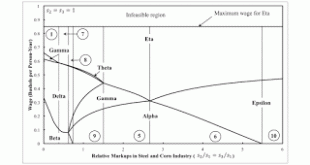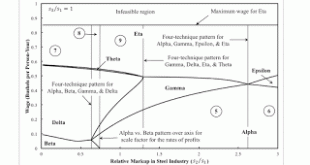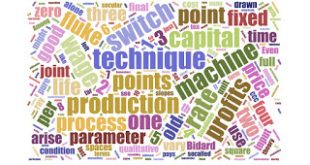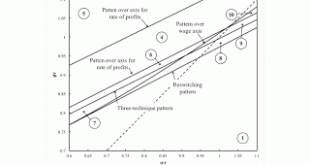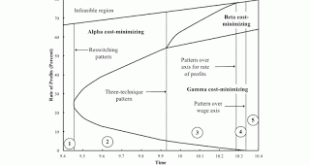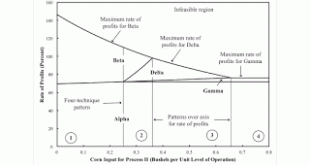Figure 1: Switch Points Varying With Perturbations In Markup In Iron Industry I have created an example with three produced commodities and a choice of technique. The three produced commodities are called iron, steel, and corn. Corn is taken to be the numeraire and the only commodity purchased by households for consumption. Markups are assumed to vary among industries, even when prices of production prevail. I was able to locate various fluke switch points in that example. The fluke switch...
Read More »Variation In Switch Points With Markups
Figure 1: Variation of Switch Points with the Markup in the Steel Industry1.0 Introduction I want to continue to analyze this example. This example does not do everything I would like with a three-commodity example. Specifically, I do not have a case of triple-switching in the parameter space I explore in this post. That space of relative markups, in a model with n industries, has (n - 1) dimensions. And it is partitioned by (n - 2)-dimensional manifolds, where each manifold corresponds to...
Read More »Two Four-Technique Patterns With Markup Pricing
Figure 1: Wage Curves for the Example1.0 Introduction The Cambridge Capital Controversy (CCC) applies to models both of competitive industries and of non-competitive industries. Around a switch point exhibiting capital-reversing, a higher wage is associated with greater employment per unit of net output produced. It is not merely a question of what technology is available. It is also a matter of the power of firms among industries to extract value from their workers, their upstream...
Read More »Fluke Switch Points in Pure Fixed Capital Systems
I have a working paper at the Centro Sraffa. Abstract: This article considers structural economic dynamics, in models with fixed capital and a choice of technique, of the production of commodities. Fluke switch points are described and cataloged. For fluke switch points, parameter perturbations create a qualitative change in how the choice of technique varies with distribution. Techniques are presented for visualizing partitions of parameter spaces such that the analysis of the choice of...
Read More »The Tractor-Corn Model: A Start
1.0 Introduction In my ROBE article, I consider fluke switch points arising from perturbations of coefficients of production in the Samuelson-Gargenani model, but in the case with only circulating capital. An obvious generalization is to consider fixed capital. This generalization is simplified by restricting oneself to the case in which machines operate with constant efficiency. Steedman (2020) analyzes this case, and this post is a start on working through elements of the corn-tractor...
Read More »The Truncation Of The Economic Lives Of Machines
'Paradoxes' and 'Perversities' PhenomenonExampleRegionReswitching'One good'5Schefold reswitching3Schefold roundabout3Baldone8Recurrence of technique (without reswitching)Baldone9Recurrence of truncation (without reswitching or recurrence of technique)Two sectors with fixed capital2Non-monotonic variation of economic life of machine (without reswitching or recurrence of technique or of truncation)Baldone10'Non-continuous' variation in economic life of machine associated with infinitesimal...
Read More »More On Baldone Example
Figure 1: A Two-Dimensional Pattern Diagram, Enlarged1.0 Introduction This post further generalizes an example from Salvatore Baldone.. Like an example from Bertram Schefold, I find that Baldone's example is in a wedge near the edge of the appropriate region in one of my partitions of a parameter space. I have some very complicated spreadsheets that allow me to quickly visualize the effects of varying parameters. Baldone and Schefold were working long before Visicalc, Microsoft Excel, or...
Read More »An Extension Of An Example From Salvatore Baldone
Figure 1: A Pattern Diagram, Enlarged1.0 Introduction This post looks at and generalizes an example of the recurrence of techniques by Salvatore Barone. It is an example with fixed capital illustrating the recurrence of the period of truncation. In the generalization, I find what I call patterns over the axis for the rate of profits, a patern over the wage axis, a three-technique pattern, and a reswitching pattern. Barone's example demonstrates that around a switch point, a lower rate of...
Read More »Triple Switching and Fluke Switch Points
Figure 1: A Pattern Diagram with Triple Switching In demonstrating the lack of foundation for claims of the Austrian school about the supposed relationships between a greater supply of capital, a consequent lower rate of profits, and a longer period of production, I have so far only presented examples in which the economic life of an existing machine can be extended or truncated. Schefold (1980: 170) interprets a more roundabout technique as one in which a long-lived machine is used to...
Read More »Recurrence Of Truncation In A Perturbation Analysis
Figure 1: Variation of Choice Of Technique with a Coefficient of Production This post continues the analysis of this example. The coefficients of production and the techniques are the same as in the linked post, except here I consider the results of varying a1, 2, the amount of corn needed as circulating capital in operating Process II at unit level. Figure 1 above shows how the choice of technique varies with this parameter. This is a two-sector model, in which new machines and corn are...
Read More » Heterodox
Heterodox

